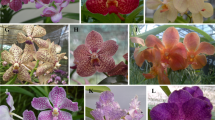Abstract
A new procedure for in vitro propagation of orchids belonging to the genus Phalaenopsis was developed. In contrast to commonly employed propagation methods that make use of leaf, root, or shoot tip tissues, we have used elongated stems of 6-benzyladenine-induced young seedlings as starting material for propagation. The elongated stem consisted of several nodes of which top nodes were used for cyclic propagation of new explants and the middle nodes for producing shoots or multiple adventitious buds. The whole procedure of proliferation could be completed within 7 months, and about 2,300 plantlets were produced from a single induced stem in a single year. This method may be used for propagation of seedlings in the case of lack of seeds in orchid breeding or for propagation of vegetative buds developed on flower stalks of rare orchid varieties when available flower stalks are limited. It may also have great potential for the propagation of wild threatened orchid species.
Similar content being viewed by others
Abbreviations
- PLB(s):
-
protocorm-like body(ies)
- zeatin:
-
6-(4-hydroxy-3-methylbut-trans-2-enylamino)purine
- 2ip:
-
6-(γ,γ-dimethylallylamino)purine
- kinetin:
-
6-furfurylaminopurine
- BA:
-
6-benzyladenine
References
Arditti J, Ball EA, Reisinger DM (1977) Culture of flower-stalk buds: A method for vegetative propagation of Phalaenopsis. Am Orchid Soc Bull 46:236–240
Arditti J, Robert E (1993) Micropropagation of orchids. John Wiley and Sons, New York, pp. 467–520
Homma Y, Asahira T (1985) New means of Phalaenopsis propagation with internodal sections of flower stalk. J Jpn Soc Hort Sci 54:379–387
Ichihashi S (1992) Micropropagation of Phalaenopsis through the culture of lateral buds from young flower stalks. Lindleyana 7:208–215
Imre AT (1987) Hormonal regulation of apical dominance. In: Davies PJ (ed) Plant hormones and their role in plant growth and development. Martinus Nijhoff, Dordrecht, pp 397–399
Intuwong O, Sagawa Y (1974) Clonal propagation of Phalaenopsis by shoot tip culture. Am Orchid Soc Bull 43:893–895
Pieper W, Zimmer K (1976) Clonal propagation of Phalaenopsis in vitro. Acta Hort 64:21–23
Tanaka M, Hasegawa A, Goi M (1975) Study on the clonal propagation of monopodial orchids by tissue culture. I. Formation of protocorm-like bodies from leaf tissue in Phalaenopsis and Vanda. J Jpn Soc Hort Sci 44:47–58
Tanaka M, Senda Y, Hasegawa A (1976) Plantlet formation by root-tip culture in Phalaenopsis. Am Orchid Soc Bull 45:1022–1024
Tokuhara K, Mii M (1993) Micropropagation of Phalaenopsis and Doritaenopsis by culturing shoot tips of flower stalk buds. Plant Cell Rep 13:7–11
Yoneda K, Momose H (1988) PLB and plantlet formation by root-tip culture in Phalaenopsis. Bull Coll Agric Vet Med Nihon Univ 45:191–196
Zimmer K, Pieper W (1978) Clonal propagation of Phalaenopsis by excised buds. Orchid Rev 86:223–227
Author information
Authors and Affiliations
Rights and permissions
About this article
Cite this article
Duan, JX., Chen, H. & Yazawa, S. In vitro propagation of Phalaenopsis via culture of cytokinin-induced nodes. J Plant Growth Regul 15, 133–137 (1996). https://doi.org/10.1007/BF00198928
Received:
Accepted:
Issue Date:
DOI: https://doi.org/10.1007/BF00198928




